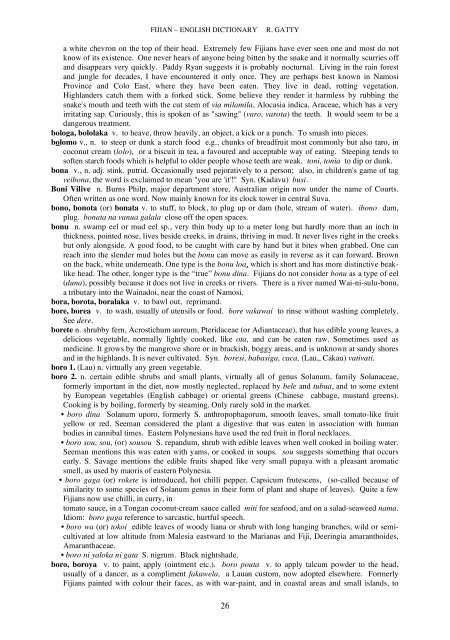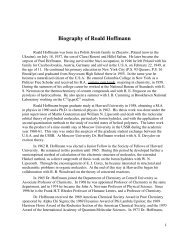Fijian-English Dictionary - eCommons@Cornell - Cornell University
Fijian-English Dictionary - eCommons@Cornell - Cornell University
Fijian-English Dictionary - eCommons@Cornell - Cornell University
Create successful ePaper yourself
Turn your PDF publications into a flip-book with our unique Google optimized e-Paper software.
FIJIAN – ENGLISH DICTIONARY R. GATTY<br />
a white chevron on the top of their head. Extremely few <strong>Fijian</strong>s have ever seen one and most do not<br />
know of its existence. One never hears of anyone being bitten by the snake and it normally scurries off<br />
and disappears very quickly. Paddy Ryan suggests it is probably nocturnal. Living in the rain forest<br />
and jungle for decades, I have encountered it only once. They are perhaps best known in Namosi<br />
Province and Colo East, where they have been eaten. They live in dead, rotting vegetation.<br />
Highlanders catch them with a forked stick. Some believe they render it harmless by rubbing the<br />
snake's mouth and teeth with the cut stem of via milamila, Alocasia indica, Araceae, which has a very<br />
irritating sap. Curiously, this is spoken of as "sawing" (varo, varota) the teeth. It would seem to be a<br />
dangerous treatment.<br />
bologa, bololaka v. to heave, throw heavily, an object, a kick or a punch. To smash into pieces.<br />
bolomo v., n. to steep or dunk a starch food e.g., chunks of breadfruit most commonly but also taro, in<br />
coconut cream (lolo), or a biscuit in tea, a favoured and acceptable way of eating. Steeping tends to<br />
soften starch foods which is helpful to older people whose teeth are weak. toni, tonia to dip or dunk.<br />
bona v., n. adj. stink. putrid. Occasionally used pejoratively to a person; also, in children's game of tag<br />
veibona, the word is exclaimed to mean "you are 'it'!" Syn. (Kadavu) busi.<br />
Boni Vilive n. Burns Philp, major department store, Australian origin now under the name of Courts.<br />
Often written as one word. Now mainly known for its clock tower in central Suva.<br />
bono, bonota (or) bonata v. to stuff, to block, to plug up or dam (hole, stream of water). ibono dam,<br />
plug. bonata na vanua galala close off the open spaces.<br />
bonu n. swamp eel or mud eel sp., very thin body up to a meter long but hardly more than an inch in<br />
thickness, pointed nose, lives beside creeks, in drains, thriving in mud. It never lives right in the creeks<br />
but only alongside. A good food, to be caught with care by hand but it bites when grabbed. One can<br />
reach into the slender mud holes but the bonu can move as easily in reverse as it can forward. Brown<br />
on the back, white underneath. One type is the bonu loa, which is short and has more distinctive beaklike<br />
head. The other, longer type is the “true” bonu dina. <strong>Fijian</strong>s do not consider bonu as a type of eel<br />
(duna), possibly because it does not live in creeks or rivers. There is a river named Wai-ni-sulu-bonu,<br />
a tributary into the Wainadoi, near the coast of Namosi.<br />
bora, borota, boralaka v. to bawl out, reprimand.<br />
bore, borea v. to wash, usually of utensils or food. bore vakawai to rinse without washing completely.<br />
See dere.<br />
borete n. shrubby fern, Acrostichum aureum, Pteridaceae (or Adiantaceae), that has edible young leaves, a<br />
delicious vegetable, normally lightly cooked, like ota, and can be eaten raw. Sometimes used as<br />
medicine. It grows by the mangrove shore or in brackish, boggy areas, and is unknown at sandy shores<br />
and in the highlands. It is never cultivated. Syn. boresi, babasiga, caca, (Lau,, Cakau) vativati.<br />
boro 1. (Lau) n. virtually any green vegetable.<br />
boro 2. n. certain edible shrubs and small plants, virtually all of genus Solanum, family Solanaceae,<br />
formerly important in the diet, now mostly neglected, replaced by bele and tubua, and to some extent<br />
by European vegetables (<strong>English</strong> cabbage) or oriental greens (Chinese cabbage, mustard greens).<br />
Cooking is by boiling, formerly by steaming. Only rarely sold in the market.<br />
• boro dina Solanum uporo, formerly S. anthropophagorum, smooth leaves, small tomato-like fruit<br />
yellow or red. Seeman considered the plant a digestive that was eaten in association with human<br />
bodies in cannibal times. Eastern Polynesians have used the red fruit in floral necklaces.<br />
• boro sou, sou, (or) sousou S. repandum, shrub with edible leaves when well cooked in boiling water.<br />
Seeman mentions this was eaten with yams, or cooked in soups. sou suggests something that occurs<br />
early. S. Savage mentions the edible fruits shaped like very small papaya with a pleasant aromatic<br />
smell, as used by maoris of eastern Polynesia.<br />
• boro gaga (or) rokete is introduced, hot chilli pepper, Capsicum frutescens, (so-called because of<br />
similarity to some species of Solanum genus in their form of plant and shape of leaves). Quite a few<br />
<strong>Fijian</strong>s now use chilli, in curry, in<br />
tomato sauce, in a Tongan coconut-cream sauce called miti for seafood, and on a salad-seaweed nama.<br />
Idiom: boro gaga reference to sarcastic, hurtful speech.<br />
• boro wa (or) tokoi edible leaves of woody liana or shrub with long hanging branches, wild or semicultivated<br />
at low altitude from Malesia eastward to the Marianas and Fiji, Deeringia amaranthoides,<br />
Amaranthaceae.<br />
• boro ni yaloka ni gata S. nigrum. Black nightshade.<br />
boro, boroya v. to paint, apply (ointment etc.). boro pouta v. to apply talcum powder to the head,<br />
usually of a dancer, as a compliment fakawela, a Lauan custom, now adopted elsewhere. Formerly<br />
<strong>Fijian</strong>s painted with colour their faces, as with war-paint, and in coastal areas and small islands, to<br />
26

















